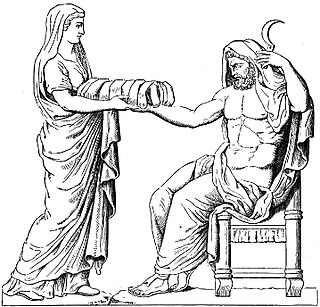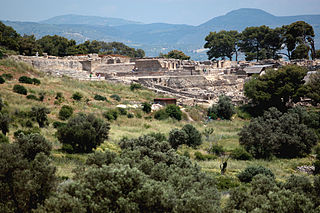
In ancient Greek religion and mythology, Demeter is the Olympian goddess of the harvest and agriculture, presiding over crops, grains, food, and the fertility of the earth. Although she is mostly known as a grain goddess, she also appeared as a goddess of health, birth, and marriage, and had connections to the Underworld. She is also called Deo. In Greek tradition, Demeter is the second child of the Titans Rhea and Cronus, and sister to Hestia, Hera, Hades, Poseidon, and Zeus. Like her other siblings but Zeus, she was swallowed by her father as an infant and rescued by Zeus.

In ancient Greek religion, Hera is the goddess of marriage, women, and family, and the protector of women during childbirth. In Greek mythology, she is queen of the twelve Olympians and Mount Olympus, sister and wife of Zeus, and daughter of the Titans Cronus and Rhea. One of her defining characteristics in myth is her jealous and vengeful nature in dealing with any who offended her, especially Zeus's numerous adulterous lovers and illegitimate offspring.

In ancient Greek mythology and religion, Leto is a goddess and the mother of Apollo and Artemis. She is the daughter of the Titans Coeus and Phoebe, and the sister of Asteria.

Zeus is the sky and thunder god in ancient Greek religion and mythology, who rules as king of the gods on Mount Olympus. His name is cognate with the first syllable of his Roman equivalent Jupiter.

In Greek mythology, Amalthea or Amaltheia is the most-frequently mentioned foster-mother of Zeus.

Rhea or Rheia is a mother goddess in ancient Greek religion and mythology, the Titaness daughter of the earth goddess Gaia and the sky god Uranus, himself a son of Gaia. She is the older sister of Cronus, who was also her consort, and the mother of the five eldest Olympian gods and Hades, king of the underworld.

According to Greek mythology, the Korybantes or Corybantes were the armed and crested dancers who worshipped the Phrygian goddess Cybele with drumming and dancing. They are also called the Kurbantes in Phrygia.

Cybele is an Anatolian mother goddess; she may have a possible forerunner in the earliest neolithic at Çatalhöyük. She is Phrygia's only known goddess, and was probably its national deity. Greek colonists in Asia Minor adopted and adapted her Phrygian cult and spread it to mainland Greece and to the more distant western Greek colonies around the 6th century BC.
In ancient Greek religion and mythology, Adrasteia, also spelled Adrastia, Adrastea, Adrestea, Adastreia or Adrasta, originally a Phrygian mountain goddess, probably associated with Cybele, was later a Cretan nymph, and daughter of Melisseus, who was charged by Rhea with nurturing the infant Zeus in secret, to protect him from his father Cronus. By at latest the fifth century BC, she became identified with Nemesis, the goddess of divine retribution.

Britomartis was a Greek goddess of mountains and hunting, who was primarily worshipped on the island of Crete. She was sometimes believed to be an oread, or a mountain nymph, but she was often conflated or syncretized with Artemis and Aphaea, the "invisible" patroness of Aegina. She is also known as Dictynna or as a daughter of Dictynna.
In Greek mythology, Dardanus was the founder of the city of Dardanus at the foot of Mount Ida in the Troad.

In Greek mythology, Ixion was king of the Lapiths, the most ancient tribe of Thessaly.

Phaistos ), also transliterated as Phaestos, Festos and Latin Phaestus, is a Bronze Age archaeological site at modern Faistos, a municipality in south central Crete. It is notable for the remains of a Minoan palace and the surrounding town.
In Greek mythology, the Dactyls or Daktyloi were the archaic mythical race of male beings associated with the Great Mother, whether as Cybele or Rhea. Their numbers vary, but often they were ten spirit-men so like the three Korybantes or the Cabeiri that they were often interchangeable. The Dactyls were both ancient smiths and healing magicians. In some myths, they are in Hephaestus' employ, and they taught metalworking, mathematics, and the alphabet to humans.

Mount Ida is a mountain in northwestern Turkey, some 20 mi (32 km) southeast of the ruins of Troy, along the north coast of the Edremit Gulf. It is between Balıkesir Province and Çanakkale Province.

Mount Ida, known variously as Idha, Ídhi, Idi, and Ita, is the highest mountain on the island of Crete, with an elevation of 2,456 metres (8,058 ft). It has the highest topographic prominence of any mountain in Greece. A natural park which includes Mount Ida is a member of UNESCO's Global Geoparks Network.

Psychro Cave is an ancient Minoan sacred cave in Lasithi plateau in the Lasithi district of eastern Crete. Psychro is associated with the Diktaean Cave, one of the putative sites of the birth of Zeus. Other legends place Zeus' birthplace as Idaean Cave on Mount Ida. According to Hesiod, Theogony, Rhea gave birth to Zeus in Lyctus and hid him in a cave of Mount Aegaeon. Since the late nineteenth century the cave above the modern village of Psychro has been identified with Diktaean Cave, although there are other candidates, especially a cave above Palaikastro on Mount Petsofas.
In Greek mythology, Corybas is the son of Iasion and the goddess Cybele, who gave his name to the Corybantes (Koribantes), or dancing priests of Phrygia. The Korybantes were associated with Orpheus, another son of Apollo and a Mousa, founder of the closely related Orphic Mysteries.

In Ancient Greek religion and mythology, Cronus, Cronos, or Kronos was the leader and youngest of the first generation of Titans, the divine descendants of the primordial Gaia and Uranus. He overthrew his father and ruled during the mythological Golden Age, until he was overthrown by his own son Zeus and imprisoned in Tartarus. According to Plato, however, the deities Phorcys, Cronus, and Rhea were the eldest children of Oceanus and Tethys.
Idaea or Idaia is the name of several figures in Greek mythology, it means "she who comes from Ida" or "she who lives on Ida", and is often associated with Mount Ida in Crete, and Mount Ida in the Troad.















